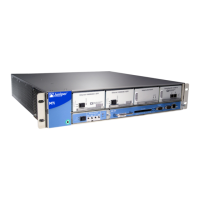CHAPTER 12
Network Cable and Transceiver Planning
•
Fiber-Optic and Network Cable Specifications for the M7i Router on page 91
•
Attenuation and Dispersion in Fiber-Optic Cable on M Series, MX Series, and T Series
Routers on page 91
•
Signal Loss in Multimode and Single-Mode Fiber-Optic Cable for the M7i
Router on page 92
•
Calculating Power Budget for Fiber-Optic Cable for M Series, MX Series, and T Series
Routers on page 93
•
Calculating Power Margin for Fiber-Optic Cable for M Series, MX Series, and T Series
Routers on page 94
Fiber-Optic and Network Cable Specifications for the M7i Router
The router supports PICs that use various kinds of network cable, including multimode
and single-mode fiber-optic cable. For information about the type of cable used by each
PIC, see the M7i Multiservice Edge Router Interface Module Reference.
Related
Documentation
Attenuation and Dispersion in Fiber-Optic Cable on M Series, MX Series, and T Series
Routers on page 91
•
• Signal Loss in Multimode and Single-Mode Fiber-Optic Cable for the M7i Router on
page 92
• Calculating Power Budget for Fiber-Optic Cable for M Series, MX Series, and T Series
Routers on page 93
• Calculating Power Margin for Fiber-Optic Cable for M Series, MX Series, and T Series
Routers on page 94
Attenuation and Dispersion in Fiber-Optic Cable on M Series, MX Series, and T Series
Routers
Correct functioning of an optical data link depends on modulated light reaching the
receiver with enough power to be demodulated correctly. Attenuation is the reduction in
power of the light signal as it is transmitted. Attenuation is caused by passive media
components, such as cables, cable splices, and connectors. While attenuation is
significantly lower for optical fiber than for other media, it still occurs in both multimode
91Copyright © 2019, Juniper Networks, Inc.

